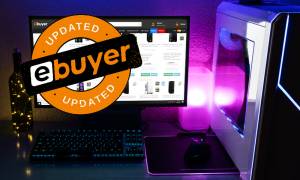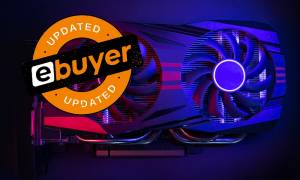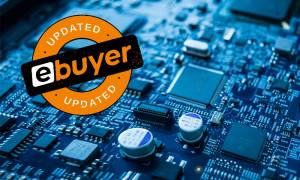This blog was updated in June 2022.
When it comes to purchasing a new PC, your mind might jump to the traditional tower-style or perhaps even to building your own. But there’s a valid alternative to the tower-based desktop PCs you’ll find in the majority of homes and offices. All-in-one PCs.
All-in-one PCs bring a whole host of benefits that you simply don’t get with a standard tower. To help you decide if an all-in-one PC might be the right choice for you, we’re comparing desktops and all-in-ones against each other, assessing their strengths and weakness to see why an all-in-one could prove a wiser choice for you.
What is an all-in-one PC?
All-in-one PCs are essentially desktops. Visually, they’re quite similar to your normal computer setup, except without that chunky tower case full of components. The internal workings of an all-in-one are built into the back of the computer monitor, negating the need for a separate device hooked up to a screen. Think Apple iMacs.
As with tower PCs, all the major computer manufacturers are active in the all-in-one market, and the larger your budget, the more power and additional features you’ll get, allowing all-in-ones to match many standard desktops in their capabilities.

(Shutterstock)
The advantages of an all-in-one PC
The primary advantage that all-in-on PCs have over their tower counterparts is their size. Stood next to a tower PC, you can immediately see how much space you can save with a pre-built package.
Tower PCs can be quite bulky and a little ungainly. All-in-ones, on the other hand, often come with large, impressive screens, and a slick design, potentially making them a much more attractive proposition for the home or office environment.
Secondly, given all-in-ones are built with everything you need straight out of the box, their superior ease in set-up and simple, general day-to-day use is one of their biggest draws.
Finding all the right specifications and peripherals for a desktop PC can be a time-consuming process. With an all-in-one PC, the system’s features are built-in from the off. This is particularly advantageous in the display, which can come with a built-in camera for video calls, and a touchscreen.
Similarly, TV tuners are also a common feature in all-in-one PCs, allowing them to be suitable as a replacement for the TV in your bedroom if you have one.
With Blu-ray players and HDMI output also widely available, allowing you to hook up game consoles to mid-to-high-end systems, the potential for your all-in-one to become something of a focal point for the room it’s in.
Again, these features are unleashed as soon as you plug the system in, keeping cumbersome wires, power units, and numerous external devices to a minimum.
The disadvantages of an all-in-one PC
So, with all those nifty advantages in mind, you might be ready to grab an all-in-one PC right now. However, before you pick up a new all-in-one, there are a couple of significant drawbacks you should be aware of.
First and foremost, components. The great strength of being slim, space-efficient, and providing a user-friendly design, also leads to the greatest failure of all-in-one PCs.
The ‘trade off’ for having a smaller system is that it contains less powerful components. All-in-ones are often powered by laptop versions of the listed CPU and graphics card.
These tend to pump out considerably less power, and as a consequence, this may leave anyone with even a mildly serious interest in gaming at a bit of a loss. They can’t run triple-A games effectively.
Replacing those parts with better versions is a pipe dream for many all-in-one users. Given the device’s restrictions on space, users aren’t able to upgrade the internal components, aside from perhaps the RAM.

(Shutterstock)
Which is better, a laptop or an all-in-one PC?
Given the smaller size and limits on component power in all-in-one PCs, you might be reading this and wondering why you don’t just buy a laptop instead. After all, a gaming laptop can be incredibly powerful while still providing many of the all-in-one PC benefits.
While a valid point, your decision on whether or not to buy a laptop or an all-in-one PC will come down to your needs. If portability is what you’re after, then obviously, you’ll want to buy a laptop. But if all you’re after is a smaller PC that takes up less space, then you should grab an all-in-one instead.
Are all-in-one PCs good?
Asking whether or not all-in-one PCs are good is a rather subjective question and, again, really comes down to your personal needs.
In terms of value, all-in-ones align themselves quite favourably with laptops. But when you line up the specifications of a tower PC and an all-in-one at the same price point, the desktop will no doubt contain far superior components. Sub in a similarly priced laptop and the gap is likely to narrow.
So, should you pick an all-in-one or a desktop?
The trade-offs required for all-in-ones do lean quite heavily toward certain types of users. Given the large screens that all-in-ones typically come bundled in, they are often favoured by those who intend to use the system for video editing or graphic design.
Most all-in-ones will tend to range between 21” and 27” in screen size, with a Full HD display increasingly being standard.
As we mentioned, of particular interest to designers is Apple’s version of the all-in-one, the iMac. Harnessing Apple’s designer-friendly software, video and graphic designers will often swear by the advantages of an Apple all-in-one for their purposes.
An all-in-one’s potential as an entertainment core can also lend itself well to those who use their computer for a large amount of content viewing.
If you just want a PC with a great screen for streaming, playing DVDs or Blu-rays, and using the inbuilt TV tuner, then an all-in-one is a genuine alternative.

(Shutterstock)
Are all-in-one PCs good for an office?
Given the superior design, an all-in-one can slip seamlessly into the set-up of your office or bedroom, without becoming an ungainly lump loitering in the corner of the room. A point which also makes the all-in-one a great option in the office environment.
As previously mentioned, creative workers often prefer the use of Apple’s all-in-one for the advantages the company’s software brings to design work and the unit’s convenience.
In general, however, the sleek design of an all-in-one can aid in the organisation of an uncluttered office. If space is a genuine concern in your cramped workplace, consider replacing your hulking great tower PCs with all-in-ones.
Which all-in-one PC is best?
Much like asking whether desktop PCs are better than all-in-ones, the question of which all-in-one PC is best is also highly subjective.
Generally speaking, iMacs tend to be the most favoured all-in-one PCs thanks to their sleek design and powerful systems. The Apple eco-system also means that you can work on the same projects on your iMac one day and your Apple laptop the next.
Of course, there are plenty of other all-in-one options out there, and you should research the ones that take your interest to ensure their specifications meet your needs.
Should I buy an all-in-one PC or a desktop?
If you fit any of the criteria we’ve discussed, then considering the wide range of all-in-ones on the market today is a viable and sensible option for you. If you don’t have any specific needs, though, a standard tower-based desktop and screen is usually a pretty sensible recommendation.
Even when your PC starts to feel a little bit ropey, opening it up and swapping in some new parts can keep an original PC purchase running well beyond an all-in-one’s sell-by date.
Like life in general, time can very quickly sneak up on your all-in-one! When you require a new one, the entire system will need to be replaced, and that can be expensive.
With the advances in the capability of PC components happening at breakneck speeds, and so narrow is the scope you’ll have to upgrade your PC’s internals, it may not be too long before your new all-in-one is considered out of date.
But you can minimise this effect by investing in the best set of components your budget will allow. You may not need the extra level of CPU right now – but pretty soon you might.
So, to help you stay ahead of the curve and keep your desktop or gaming PC alive and kicking in our ever-advancing world, we sell every component you could need in the Ebuyer store. From graphics cards and RAM to motherboards and solid-state drives, you’ll be spoilt for choice once you start browsing.
Don’t forget to check out the Ebuyer blog as well for more articles like this one!

























